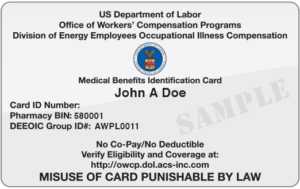Both the EEOICPA & RECA are federal government initiatives designed to compensate former government employees and contractors who were exposed to harmful levels of radiation and materials during their employment. But there are some significant differences in who qualifies and the benefits they are eligible for.
In this article, we’ll address the distinctions between the two acts.
EEOICPA vs. RECA
The Energy Employees Occupational Illness Compensation Program Act (EEOICPA) provides benefits to employees who worked for the Department of Energy (DOE) and later became ill as a result of exposure to radiation and other toxic substances. The Radiation Exposure Compensation Act (RECA) also compensates individuals who were injured as a result of radiation exposure but does not limit this remedy to workers alone. There are a number of other differences between EEOICPA and RECA, including which types of benefits claimants are eligible to receive, so if you have questions about whether you qualify for home health care, it is critical to contact our experienced professional home care providers to address your concerns.
EEOICPA Coverage
EEOICPA was enacted in 2001 specifically to provide monetary compensation and medical benefits to employees who contracted certain illnesses as a result of working at DOE facilities where they were exposed to radiation. EEOICPA is divided into two parts, Part B and Part E, each of which has different eligibility requirements and benefits.
Part B provides employees or their survivors with lump sum payments of up to $150,000 plus free medical treatment for accepted conditions caused by exposure to radiation. Part E, on the other hand, covers illnesses caused not just by radiation, but by exposure to other toxic chemicals, solvents, acids and metals. Those who qualify for coverage under Part E can receive payments of up to $250,000 in addition to medical expenses. The amount of benefits received depends on each person’s level of impairment and the number of years that the claimant suffered wage loss as a result of the illness.
RECA Coverage
Under RECA, individuals who were exposed to radiation released during above-ground nuclear weapons testing and were later diagnosed with certain cancers can collect lump sum compensation awards. Covered individuals include:
- Uranium miners;
- Uranium millers;
- Ore transporters;
- Onsite participants at atmospheric nuclear weapons tests; and
- Individuals who lived downwind of a nuclear weapons test site.
Each of these groups receive a different lump sum payment. For instance, miners, millers, and transporters can collect a payment of $100,000. Onsite participants, on the other hand, receive $75,000, while eligible downwinders receive $50,000. Although RECA is similar to EEOICPA, it does not provide claimants with medical benefits. Instead, it provides eligible claimants with a lump sum payment, from which they can pay medical bills if they so desire. The one exception to this rule relates to uranium miners, millers, and haulers who may qualify for additional compensation totaling $50,000, as well as medical benefits, under EEOICPA.
Contact a Home Care Professional
The benefits offered by EEOICPA and the compensation available to qualifying individuals under RECA can make all the difference to a person who is suffering from a serious illness caused by toxic exposure. To find out what kind of medical services you or your loved one could receive through these programs, please contact a member of the experienced home care team at United Energy Workers Healthcare today.
Who We Serve
Do you have this card?

If you already have this card, then you are already approved to receive no-cost medical benefits! Call us to get started today.
In order to be eligible for EEOICPA/RECA benefits, an individual must have been employed at a covered Department of Energy facility, an approved atomic weapons facility, or at a permitted beryllium vendor. An individual must also have one of the covered conditions as a result of exposure to radiation, beryllium, or silica while employed at an accepted facility. In addition, uranium miners, millers, and ore transporters are eligible for benefits if they develop an illness as a result of exposure to toxic substances (such as radiation, chemicals, solvents, acids, and metals) and worked at a facility covered under RECA. Eligibility requirements vary by location and condition.